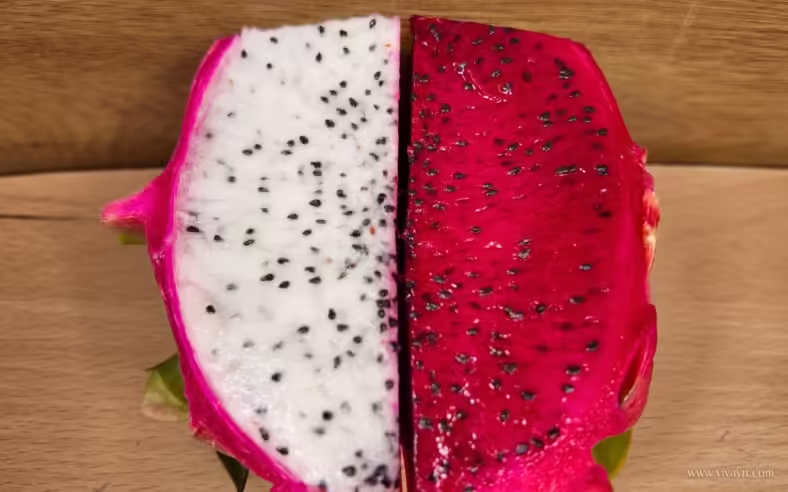
White vs Red Dragon Fruit: How to Tell the Difference
If you’ve ever stood in front of a pile of dragon fruit wondering whether you’re grabbing the red or the white kind, you’re not alone. While the outer skin of both varieties can look quite similar at first glance, there are a few subtle differences that growers and fruit sellers use to tell them apart. In this post, we’ll walk you through the differences in shape, color, sweetness, and nutrition—clearly and simply—so you can choose the one that best suits your taste or needs.
Quick comparison
Visual clues
Taste & texture
Nutrition facts
Which is better?
FAQs
Quick comparison table (for easy skimming)
Shape & Size
Fins (Bracts)
Weight
Texture
Sweetness
Aroma

White Dragon Fruit
Longer, oval-shaped
More upright fins
Lighter, less dense
Firmer, holds shape well
Mildly sweet with light tang
Almost no smell when ripe

Red Dragon Fruit
Rounder, more globe-like
Curled, bend backward
Heavier and denser
Softer, juicier
Richer, deeper sweetness
Also very little aroma
Note: Exact taste and color may vary depending on ripeness and growing conditions.
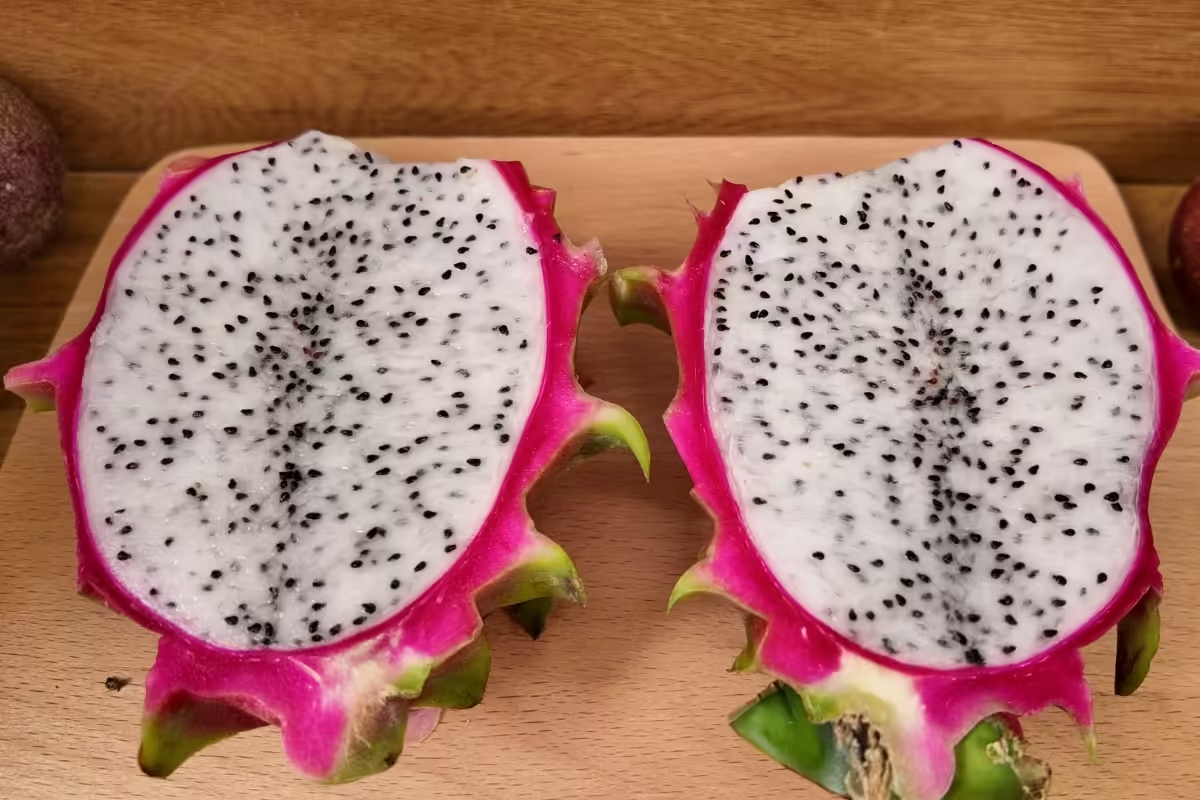
Freshly cut white dragon fruit, showing its crisp white flesh and tiny black seeds
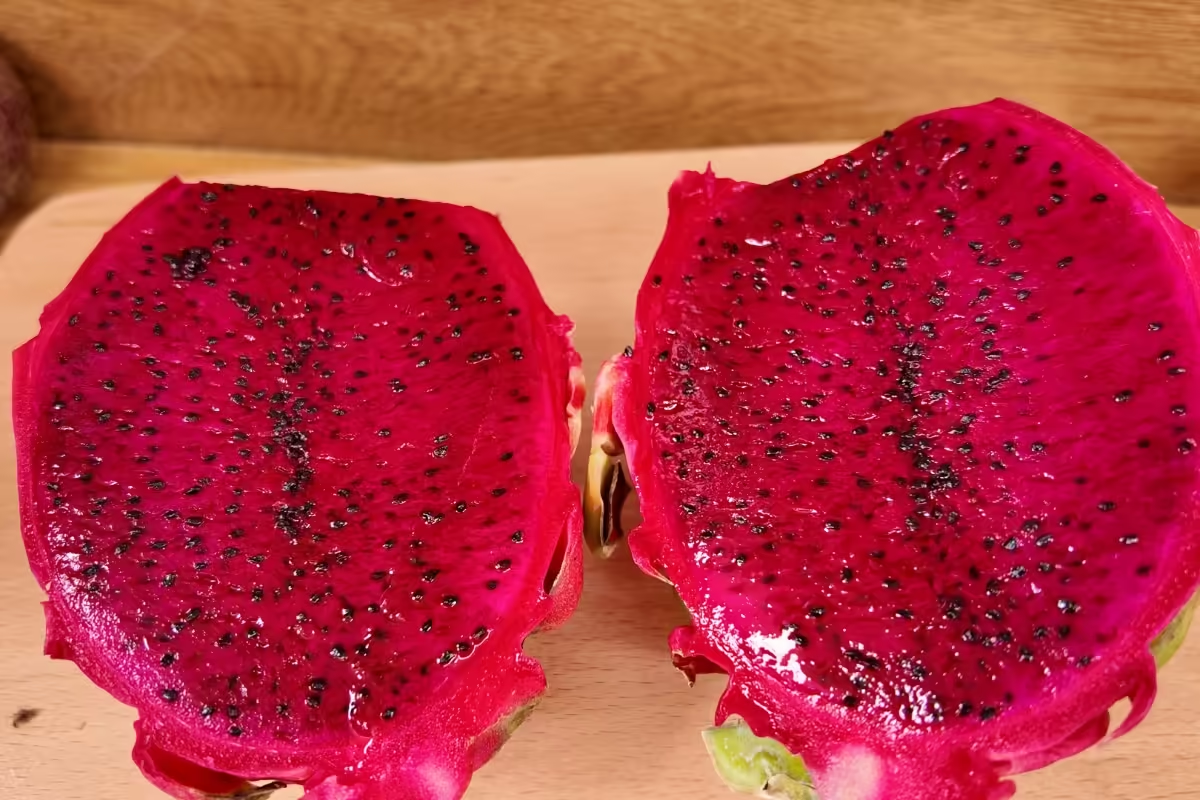
This red dragon fruit reveals bold magenta flesh
White vs red dragon fruit: Appearance tips
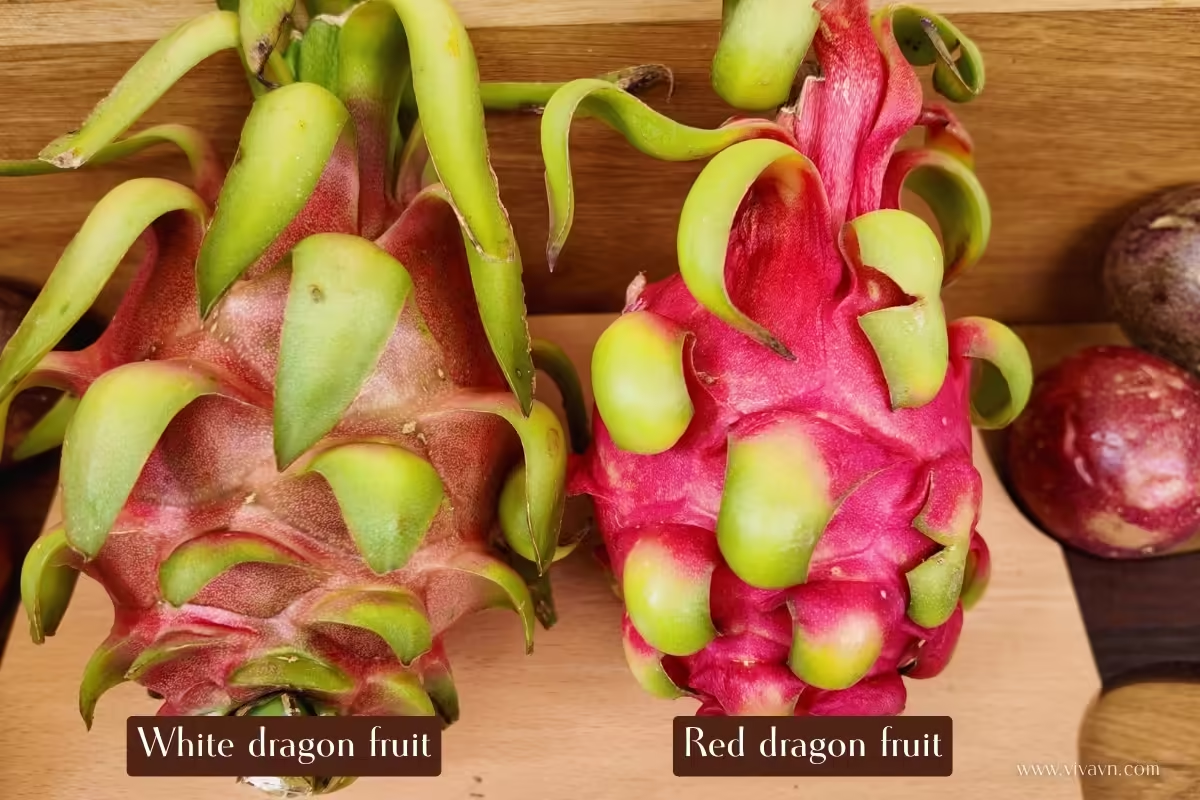
A visual comparison of white (left) and red (right) dragon fruit. Shape and bract direction are helpful clues for telling the difference before you cut into them
Shape and size
Red-fleshed dragon fruit tends to be more round, almost globe-like, while white-fleshed varieties are usually longer and more oval-shaped. In other words, if the fruit looks shorter and stubbier, it’s more likely to be red inside.
Color of the skin
The skin of the red variety is often a brighter, more vivid pink or red, compared to the paler or duller tone of the white-fleshed kind. However, this isn’t always a reliable indicator, since growing conditions can influence the skin color.
Note:
While the photo above makes the color difference between white and red dragon fruit look obvious, that’s not always the case in real life. Skin color can vary depending on growing conditions, so it’s best not to rely on color alone when trying to tell them apart.
The “fins” or bracts
Take a closer look at the green-tipped scales (often called “fins” or “ears”) that stick out from the skin. This is where experienced growers often find the most telling clue:
On white-fleshed dragon fruit, the fins are usually straighter and more upright.
On red-fleshed dragon fruit, the fins tend to curl or bend backward more dramatically.
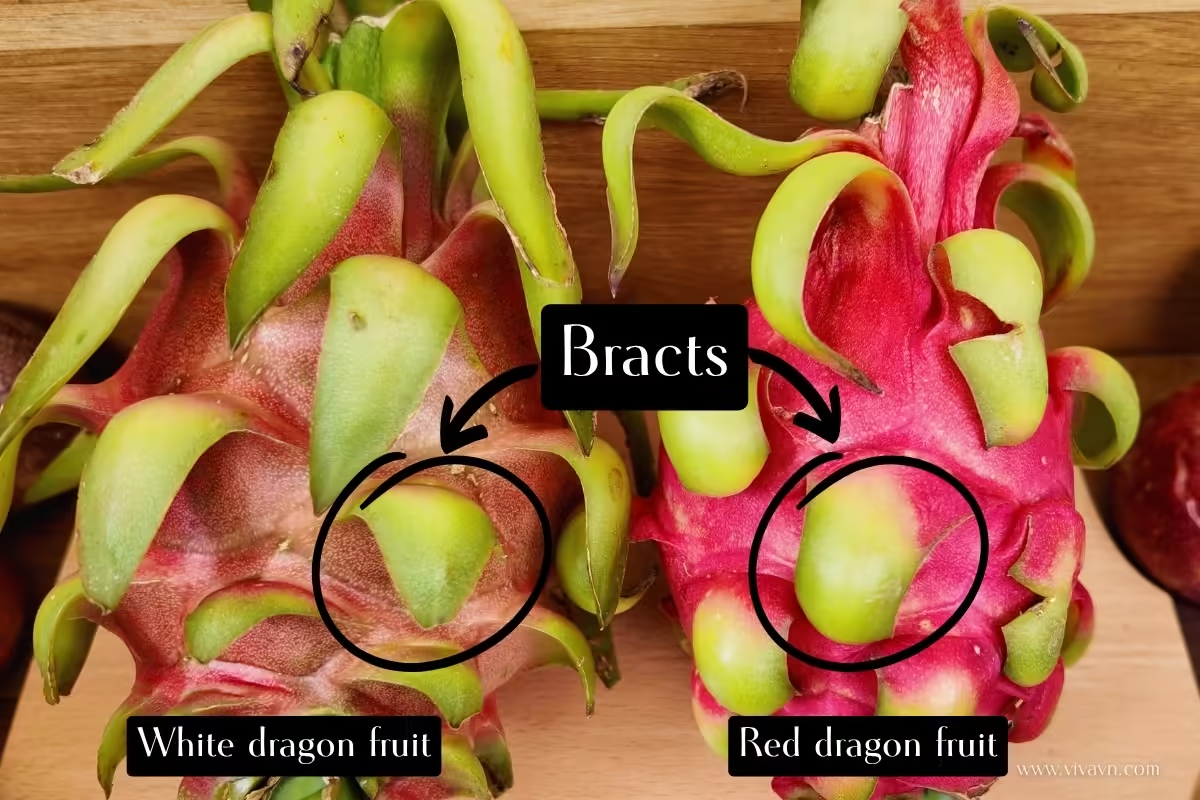
Look at the bracts
It’s a subtle difference, but many farmers consider this one of the most reliable visual signs—especially when skin color is too similar to judge.
Weight
Red dragon fruit is generally denser and heavier than white dragon fruit of the same size. Pick one of each up in your hand—you might feel the difference.
Taste and texture compared
White dragon fruit tastes mildly sweet with a gentle tang, making it light and refreshing. The red variety, on the other hand, tends to be richer, with a deeper sweetness. Interestingly, neither type gives off much aroma when ripe, so don’t expect a strong fruity smell like you might get from tropical fruits such as mango or jackfruit.
Both types have soft, hydrating flesh speckled with tiny edible black seeds. The red variety is often a bit more delicate and juicy, making it great for smoothies or spoon-eating. The white kind holds its shape better when sliced, which makes it a popular choice for fruit platters or salads.
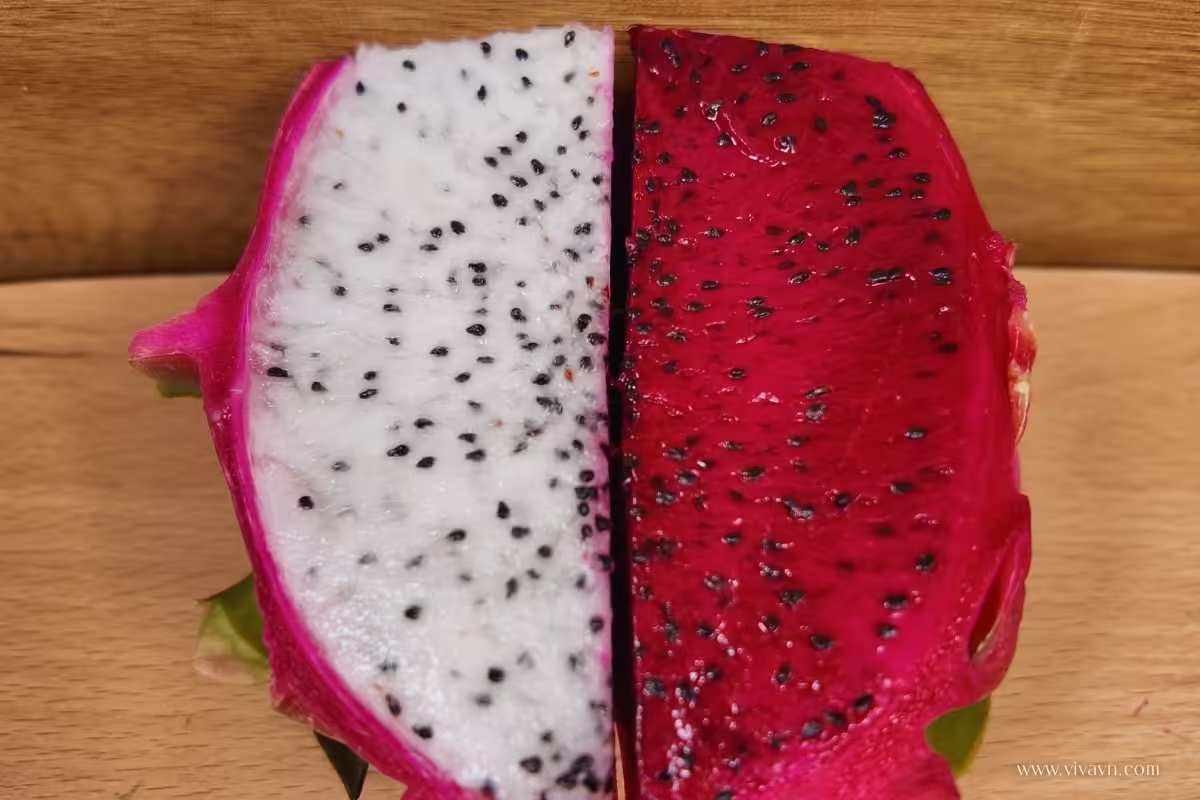
A close-up of sliced white and red dragon fruit.
Health benefits and nutrition
Low in calories, high in fiber
Both red and white dragon fruit are naturally low in calories—about 57 calories per 100 grams—and provide roughly 3.1 grams of dietary fiber. That makes them a great option for supporting healthy digestion and weight management.
Hydrating and refreshing
With high water content—about 84%, according to USDA data—both red and white dragon fruit help keep you hydrated, especially in hot weather. They’re a refreshing fruit choice during summer or after exercise.
Antioxidants in red dragon fruit
Red dragon fruit is rich in antioxidants, particularly betalains — the pigments responsible for its vibrant magenta flesh. These powerful compounds may help reduce inflammation and protect your cells from oxidative stress. Read the full 2021 scientific review on betalains in Molecules here.
If you’re curious about the exact nutrition values, here’s a quick breakdown based on a 100g serving. For the full details, you can check the official USDA database here.
| Nutrient | Amount | Notes |
|---|---|---|
| Water | 83.96 | Helps keep the body hydrated. |
| Calories | 57 kcal | A very light, low-calorie fruit. |
| Fiber | 3.1 g | Good for digestion and gut health. |
| Carbohydrates | 15.23 g | Provides natural energy with a mild sweetness. |
| Vitamin C | 4.3 mg | Supports the immune system. |
| Potassium | 116 mg | Helps maintain fluid balance and muscle function. |
| Calcium | 9 mg | May support bone and teeth health. |
| Iron | 0.18 mg | Contributes to red blood cell function. |
| Magnesium | 7 mg | Involved in muscle and nerve function. |
So, which dragon fruit is better?
It really comes down to what you’re looking for.
If you prefer a fruit that’s light, crisp, and subtly sweet, white dragon fruit is your go-to. It’s less intense in flavor, holds its shape well when sliced, and works beautifully in fruit salads or as a cooling summer snack.
If you want something bolder, sweeter, and a little juicier, red dragon fruit might be the better pick. Its vibrant magenta flesh makes smoothies pop with color, and it’s often favored for its slightly richer taste and higher antioxidant content.
That said, if you’re being mindful of sugar intake—for example, due to dietary goals or medical advice—it may be worth noting that the red variety tends to taste sweeter. As always, your personal needs and preferences should guide the best choice for you.
FAQs about white and red dragon fruit
How can you tell white and red dragon fruit apart before cutting?
Red dragon fruit is usually rounder with more curled fins (bracts), while white ones tend to be longer with straighter fins. Skin color can help—red varieties often appear brighter or more vivid. Another clue: at the same size, red dragon fruit typically feels heavier than white, due to its denser, juicier flesh.
Is red dragon fruit always sweeter than white?
Generally, yes. Red-fleshed varieties tend to have a deeper, richer sweetness. However, exact taste can vary based on how ripe the fruit is and where it was grown.
Are the seeds edible?
Yes, the small black seeds in both types are edible.
Share on FacebookShare on X (Twitter)Share on PinterestShare on WhatsappShare on LinkedinShare on TelegramShare on Email
- https://www.youtube.com/@VivaVNOfficial
- https://www.facebook.com/vivavnofficial2024
- https://www.pinterest.com/vivavnofficial/
© 2025 VivaVN. All rights reserved.

Leave a Reply